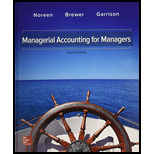
1.
Introduction:
Break-even point:
Break-even point is defined as the volume of production where the total cost is equal to the total sales revenue generated thereby resulting in a no-
To calculate the break-even point in unit sales and dollar sales.
2.
Introduction:
Break-even point:
Break-even point is defined as the volume of production where the total cost is equal to the total sales revenue generated thereby resulting in a no-profit and no loss situation. At the break-even point, the contribution earned is sufficient to cover the costs, whereas if the contribution is less than the break-even point then it is a loss and if it is more, then it is a profit.
To determine whether increasing the variable expenses as a percentage of the selling price will result in a higher or lower break-even point.
3.
Introduction:
Break-even point:
Break-even point is defined as the volume of production where the total cost is equal to the total sales revenue generated thereby resulting in a no-profit and no loss situation. At the break-even point, the contribution earned is sufficient to cover the costs, whereas if the contribution is less than the break-even point then it is a loss and if it is more, then it is a profit.
To prepare: two contribution format income statements with present operating conditions and the proposed changes.
4.
Introduction:
Break-even point:
Break-even point is defined as the volume of production where the total cost is equal to the total sales revenue generated thereby resulting in a no-profit and no loss situation. At the break-even point, the contribution earned is sufficient to cover the costs, whereas if the contribution is less than the break-even point then it is a loss and if it is more, then it is a profit.
To calculate: the number of stoves to be sold at the new selling price given in requirement 3 to attain a target profit of $ 35000 per month.
Want to see the full answer?
Check out a sample textbook solution
Chapter 3 Solutions
GEN COMBO MANAGERIAL ACCOUNTING FOR MANAGERS; CONNECT 1S ACCESS CARD
- Can you explain the correct approach to solve this financial accounting question?arrow_forwardCan you explain this general accounting question using accurate calculation methods?arrow_forwardJK Corporation is finishing its fifth year in business with a gross income of $780,000 and total deductions of $420,000. In the second year, the company had a net loss of $125,000, and in the fourth year, it had a net loss of $95,000. What is JK Corporation's taxable income for this year, assuming Net Operating Losses (NOLs) are carried forward?arrow_forward
- Why does business model analysis affect accounting choices? A. Standard methods fit all models B. Recognition rules stay fixed C. Business type remains irrelevant D. Revenue generation patterns influence recognition methods tutor give answerarrow_forwardI am looking for help with this general accounting question using proper accounting standards.arrow_forwardI need help finding the accurate solution to this general accounting problem with valid methods.arrow_forward
- Spark Industries estimates that overhead costs for the next year will be $3,950,000 for indirect labor and $780,000 for factory utilities. The company uses machine hours as its overhead allocation base. If 120,000 machine hours are planned for the next year, what is the company's plantwide overhead rate?arrow_forwardFairview Inc. owns 80 percent of Monroe Company's stock. In the 20Y8 consolidated income statement, the non controlling interest was assigned $18,400 of income. There was no differential in the acquisition. What amount of net income did Monroe Company report for 20Y8?arrow_forwardOne of Adams Manufacturing's activity cost pools is material handling, with an estimated overhead (OH) of 218,400. It produces desks (950 handling operations) and chairs (1,450 handling operations). How much $ OH should be assigned to desk material handling? A) $86,450 B) $50,000 C) $63,550 D) $100,000arrow_forward

 AccountingAccountingISBN:9781337272094Author:WARREN, Carl S., Reeve, James M., Duchac, Jonathan E.Publisher:Cengage Learning,
AccountingAccountingISBN:9781337272094Author:WARREN, Carl S., Reeve, James M., Duchac, Jonathan E.Publisher:Cengage Learning, Accounting Information SystemsAccountingISBN:9781337619202Author:Hall, James A.Publisher:Cengage Learning,
Accounting Information SystemsAccountingISBN:9781337619202Author:Hall, James A.Publisher:Cengage Learning, Horngren's Cost Accounting: A Managerial Emphasis...AccountingISBN:9780134475585Author:Srikant M. Datar, Madhav V. RajanPublisher:PEARSON
Horngren's Cost Accounting: A Managerial Emphasis...AccountingISBN:9780134475585Author:Srikant M. Datar, Madhav V. RajanPublisher:PEARSON Intermediate AccountingAccountingISBN:9781259722660Author:J. David Spiceland, Mark W. Nelson, Wayne M ThomasPublisher:McGraw-Hill Education
Intermediate AccountingAccountingISBN:9781259722660Author:J. David Spiceland, Mark W. Nelson, Wayne M ThomasPublisher:McGraw-Hill Education Financial and Managerial AccountingAccountingISBN:9781259726705Author:John J Wild, Ken W. Shaw, Barbara Chiappetta Fundamental Accounting PrinciplesPublisher:McGraw-Hill Education
Financial and Managerial AccountingAccountingISBN:9781259726705Author:John J Wild, Ken W. Shaw, Barbara Chiappetta Fundamental Accounting PrinciplesPublisher:McGraw-Hill Education





